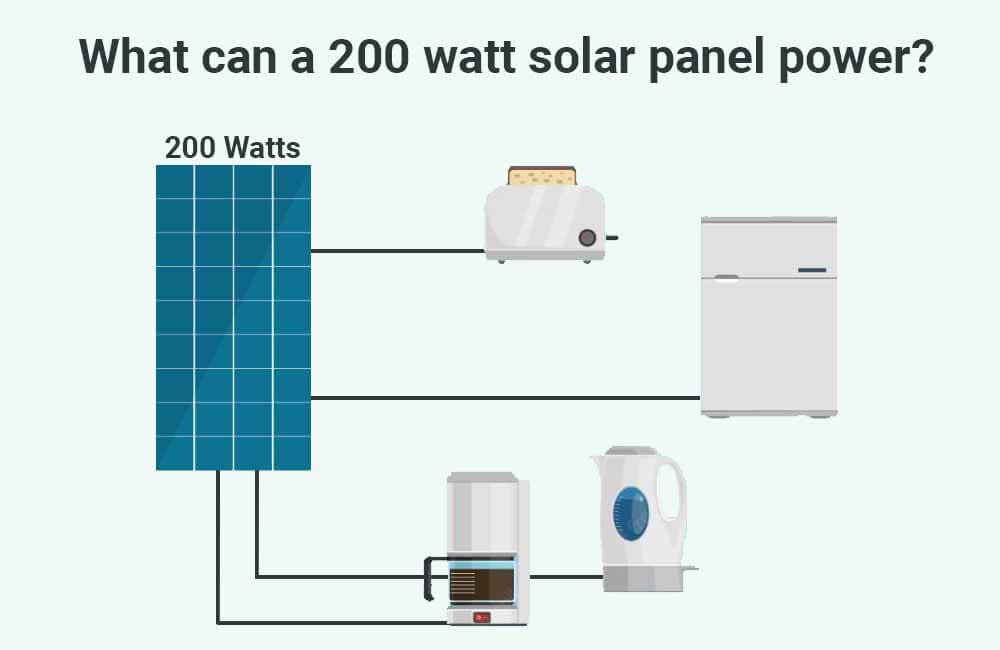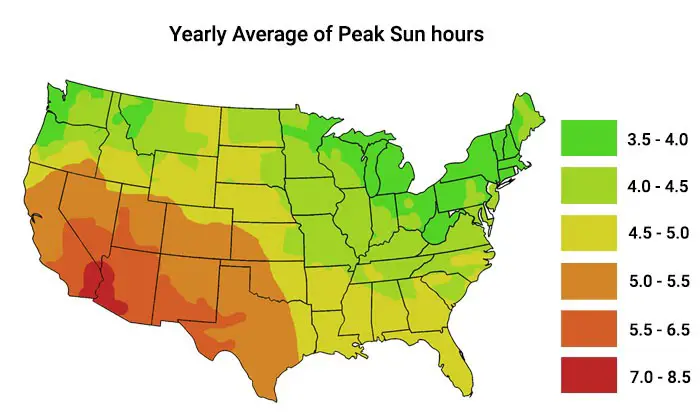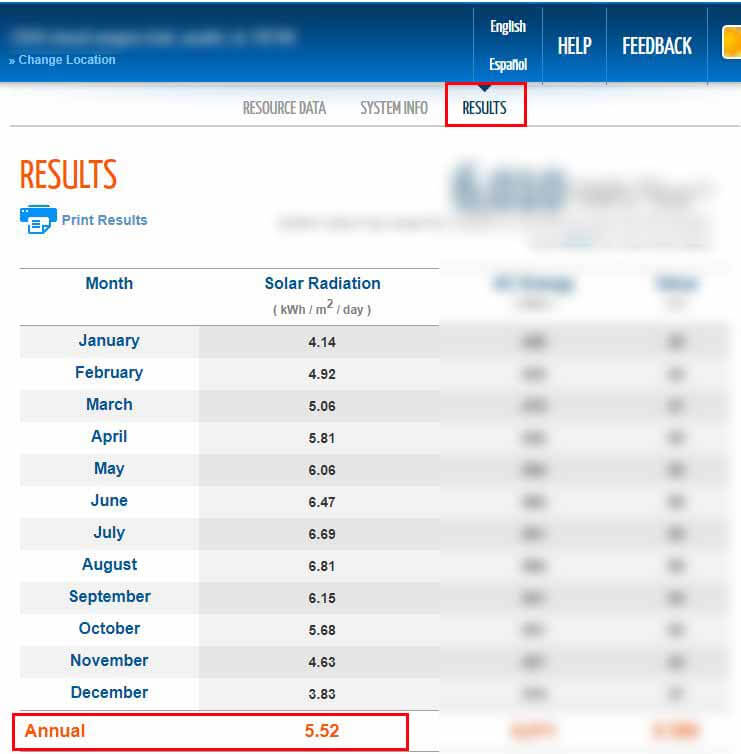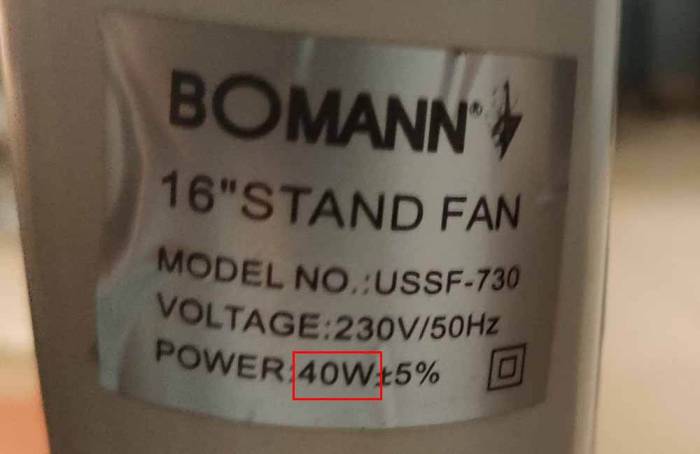In this article, I’ll help you put the electricity production capabilities of a 200 Watt solar panel into perspective, first, by answering some of the most frequently asked questions on the topic, such as:
- How much Electrical Current (Amps) does a 200 Watt solar panel produce?
- How much Electrical Power (Watts) does a 200 Watt solar panel produce?
- How much Electrical Energy (Watt-hours) does a 200 Watt solar panel produce?
And then, by comparing the amount of electricity that a solar panel of this rating produces, to the actual energy consumption of your typical appliances. By the end of this article, you’ll have a clear idea of what to expect.

I get commissions for purchases made through links in this post.
How many amps does a 200 watt solar panel produce?
In terms of current, 12V-200W solar panels are usually rated at 8 to 10 Amps. The amperage of the solar panel is generally specified by the manufacturer under Imp or Impp, which stands for Current at Maximum Power.
In other words, if enough sunlight is provided, a 12V-200W solar panel will produce between 8 and 10 Amps.
For example, this 200W solar panel from Renogy has an operating current (Impp) of 10.42 Amps.
Some 200-watt solar panels have a nominal voltage of 24 Volts instead of 12 Volts, these solar panels produce around 5 Amps of current. For example, this 200W solar panel from Rich Solar has an Impp of 5.32 Amps.
An important thing to add is that solar panels have a 2nd Current (Amperage) rating: the Short-Circuit Current, or “Isc”. This rating, also in Amps, represents the amount of current that a solar panel is capable of producing if a short circuit occurs.
The Short-Circuit Current rating on your 200W solar panel is useful when trying to size the wires and the fuses/circuit breakers that you need.
Related topics:
- What size wire from the solar panel to the charge controller?
- What size fuse between the solar panel and charge controller?
In general, the short-circuit current of a 12V-200W solar panel is usually between 9.5 and 11 Amps, depending on the panel. The short-circuit current rating of a 24V-200W solar panel is usually between 5 and 6 Amps.
How much power does a 200 watt solar panel produce?
Solar panels are rated in perfect conditions, meaning that under optimal solar irradiance (1000 W/m2) and perfect temperature (77°F), a 200 Watt solar panel will produce 200 watts. However, in the real world, and depending mainly on how sunny it is, that same panel will realistically produce anywhere from 0 to 180 Watts.
Related topics:
In other words, the power production (watts) of a 200 watt solar panel will fluctuate throughout the day, depending mainly on how much direct sunlight it is receiving.
For example, while a 200 Watt solar panel might only produce 20 Watts of power at a given moment on a cloudy morning, it might produce 180 or 190 Watts at a given moment, at noon, on a clear summer day.
Keep in mind that Power and Energy are two different things. While Electrical Power is measured in Watts (W) or kiloWatts (kW), Electrical Energy is measured in Watt-hours (Wh) or kiloWatt-hours (kWh).
Related: What is the difference between Power (W and kW) and Energy (Wh and kWh)?
Let’s see how much energy can a 200W panel produce.
How much energy does a 200-watt solar panel produce?
A 200 watt solar panel produces between 700Wh and 1300Wh of daily energy. Other than the wattage rating of the solar panel, the amount of energy it produces on a given day will depend on its location (location of installation) and weather conditions on that given day.
The best way to estimate how much energy a solar panel will produce per day is to multiply its power rating (200 watts) by the number of peak sun hours it would get each day.
Energy Production (Watt-hours) = Power rating (Watts) x Peak Sun Hours
Here’s a map of the yearly average peak sun hours that different locations in the U.S. have access to each day:

For example, let’s see how much daily energy a 200 watt panel can produce in 2 different locations.
Location 1: Houston, Texas.
Assuming a 200 watts solar panel is facing south, the yearly average of peak sun hours it would receive per day is around 5 Peak Sun Hours (per day).
Average daily energy production = 200 Watts x 5 Peak Sun Hours = 1000Wh (Watt-hours)
Location 2: Portland, Oregon.
If the same 200 watt solar panel is facing south but installed somewhere in Portland, Oregon, it would only get around 4 daily peak sun hours.
Average daily energy production = 200 Watts x 4 Peak Sun Hours = 800Wh (Watt-hours)
A more precise way of estimating the amount of energy that a 200W solar panel would produce in your location is to use the Peak Sun Hours provided by NREL’s PVWatts calculator.
All you have to do is:
- Click here.
- Submit the location of the solar panel to the tool
- And go to the “Results” section of the tool to access the data.
For example, I submitted a random address in Austin, TX, and the tool estimate that this location receives – on average – 5.52 kWh/m2 of sunlight energy per day. This is equivalent to 5.52 peak sun hours per day.

In this particular location, a 200-watt solar panel would – on average – produce 1100 Wh of energy per day (1.1 kWh/day).
You can also use monthly averages to predict energy production for a particular month. For example, in this location, a 200W solar panel would – on average – produce 828 Wh/day of energy in January.
How many amp-hours does a 200 watt solar panel produce?
A 200W / 12V solar panel can produce about 60 – 100 Ah (Amp-hours) a day.
Following the same examples used above, a person from Houston, Texas could potentially get 84 Amp-hours per day out of their 200W solar panel; while a person in Portland, Oregon would only get about 67 Amp-hours out of the same panel.
To get a perspective of what these values mean, let’s see what you can run with the amount of energy a 200W solar panel produces.
What can a 200 watt solar panel run?
Given that the appliances are not running all the time and that you manage your power consumption correctly, a 200 watt solar panel can provide enough energy to run a laptop, LED lights, an energy-efficient mini-fridge, an exhaust fan, a coffee maker, and a 32” LED TV.
To get a better understanding of what to expect, take a look at the table below which contains typical appliances and their power consumption:
| Appliances | Power input | Energy Consumption |
| Energy efficient mini-fridge | 170W starting – 70W running | Around 600Wh daily consumption if plugged in all day. |
| LED light bulb | 8W | 8Wh of energy per hour of usage. |
| Incandescent light bulb | 60W | 60Wh of energy per hour of usage. |
| 32″ LED TV | 30W | 30Wh of energy per hour of usage. |
| Exhaust fan | 20W-30W | 20Wh-30Wh of energy per hour of usage. |
| Phone charger | 5W-10W | 5Wh-10Wh of energy per hour of charging. |
| Laptop (Charged and running) | 15W-25W | 15Wh-25Wh of energy per hour of usage. |
| Laptop (Charging) | 40W-70W | 40Wh-70Wh per hour while charging. |
| Coffee maker | 700W-900W | 40Wh-60Wh of energy for each usage. |
| Toaster | 700W-900W | 40Wh-60Wh of energy for each usage. |
| Hair dryer | 1000W | 15Wh-20Wh of energy per minute of usage. |
| Table fan | 40W | 40Wh of energy per hour of use |
As long as you know how much energy you produce and how much energy you’d like to offset, you’ll be able to manage.
Keep in mind that Energy Consumption is in Watt-hours, and can be calculated by multiplying the power input of the appliance (in Watts) by the usage duration ( in hours).
Energy Consumption = Watts x hours
So, to know what a 200 watt solar panel can run for you, it’s very important to know how much energy your electric appliances consume in Watt-hours (Wh).
The values provided in the table are typical; if you can’t find what you’re looking for in the table or want more specific values, you can look for the specs label stuck or imprinted on your appliance and you’ll be able to figure out its power input.
For example, this is the specs label on my fan:

The label says the fan has a power input of 40W, so if I were to use it for 2 hours a day, it would consume 80Wh of energy (40W x 2 hours).
If the label on your device does not show a power value, look for volts (V) and amps (A).
For example if the label on the fan had 20V / 2A on it, we could easily calculate the wattage by multiplying volts by amps:
Watts = Volts x Amps
If you don’t mind using estimates for now, feel free to use our Appliance Energy Consumption Calculator.
here are 2 examples of some combinations of appliances a single 200 watt solar panel could power:
1.
| Appliance | Power input | Energy consumption |
| Coffee maker | 800 watts | 3 minutes to make coffee, 3 mins = 0.05 hour, if I use the coffee maker one time a day, its power consumption is 800 watts x 0.05 hours = 40 Wh |
| 3 LED light bulbs | 3 x 8 = 24 | If all LED light bulbs are used for 3 hours for example; 24 watts x 3 hours = 72 Wh |
| 32” LED TV | 30 watts | For 2 hours 30 watts x 2 hours = 60 Wh |
| Energy-efficient mini-fridge | 160 watts starting / 60 watts running | If the fridge is plugged in all day it will consume about 600 Wh daily |
If I were to use a coffee maker in the morning, turn on 3 LED light bulbs at once in the evening for 3 hours, watch TV for 2 hours, and have a mini-fridge plugged in all day, my energy consumption for this day would look like this:
Energy Consumption = 40Wh + 72Wh + 60Wh + 600Wh = 772Wh/day
2.
| Appliance | Power input | Energy consumption |
| Coffee maker | 800 watts | 3 minutes to make coffee, 3 mins = 0.05 hour, if I use the coffee maker one time a day, its power consumption is 800 watts x 0.05 hours = 40Wh |
| Laptop (charged and running) | 15 watts | If you use a laptop while it’s plugged in for 4 hours, its energy consumption can be calculated like this: 15 watts x 4 = 60Wh |
| 2 incandescent light bulbs | 2 x 60 watts = 120 watts | For 3 hours 120 watts x 3 hours = 360Wh |
| Exhaust fan | 20 watt | If the fan runs for 6 hours: 20 watts x 6 hours = 120Wh |
| 3 phones charging | 3 x 8 watts = 24 watts | If it takes 1 hour to charge each of the phones: 24 watts x 1 hour = 24Wh |
If I were to use a coffee maker in the morning, turn on 2 incandescent light bulbs at once in the evening for 3 hours, use my laptop for 4 hours, charge 3 phones, and have my exhaust fan on running for 6 hours, my energy consumption for this day would look like this:
Energy Consumption = 40Wh + 60Wh + 360Wh + 24Wh + 120Wh = 604Wh/day
Another important thing to note is that in order for a 200W solar panel to run your appliances, you’ll need to use a battery bank. A battery bank will allow you to store every bit of energy the solar panel produces during the day, and make it available for use whenever it is needed.
Let’s talk about the battery bank you need for a 200 watt panel.
How many batteries do I need for a 200 watt solar panel?
There are 2 things to consider when figuring out the battery capacity needed for your 200W solar panel, the battery will need to:
- Have enough capacity to store all the energy your solar panel produces throughout the day.
- Have a high enough capacity to power all the appliances without being completely depleted.
How many batteries can a 200 watt solar panel charge?
A 200W/12V solar panel that gets 5 peak sun hours a day can produce 1000Wh of energy every day. That’s enough energy to charge a 100Ah/12V battery or two 50Ah/12V batteries wired in parallel.
But depending on the chemistry of the battery or batteries you’re using, you might need more than 100Ah of battery storage.
How many batteries do I need for a 200 watt solar panel?
To properly store and use the energy produced by a 12V – 200W solar panel, you need 100Ah of battery capacity if you’re using a lithium battery, or 200Ah of battery capacity if you’re using a lead-acid battery.
For example, you’ll either need one 100Ah Lithium-Iron-Phosphate (LiFePo4) battery or two 100Ah Sealed Lead-Acid batteries wired in parallel.
Even though the energy source is the same (one 200w solar panel), the battery capacity needed is relative to the type of battery. That’s because a battery’s cycle life is affected by how deep you discharge it (depth of discharge), and some battery types are more affected by this than others.
For example, the optimal depth of discharge for a lead-acid battery is around 50%, while for a lithium battery, it’s 80% or more. If these batteries are discharged deeper than recommended, they won’t last as long as they should
For a bigger solar energy system, there are a few more variables to consider when determining the number of batteries you need.
To learn more about this, I recommend you check this article: How to calculate battery capacity for your solar panel?
Related: How long to charge a 100Ah battery with a 200W solar panel?
Once you’ve determined the size and specifications of the battery bank that you need, you’ll also need a solar charge controller to connect your 200W solar panel to the battery. Feel free to use our MPPT calculator to find the right charge controller for your setup.










Thank you for the information. I’m a complete novice at this, and your information really helps. I’m setting up a small system to use with my mid size pickup when traveling in Central America.
Just bought a 100 AH lead-acid battery + 2@ 100 watt panels + 40 amp MPPT charge controller. If needed I’ll have room for 2 more panels and another battery, and your info pointed me in the right direction.
Very nice explanation for all who need more solar learning. Thanks engineer younes.
Thanks for the information it’s really helps me a lot as technician and I want to learn more about renewable energy
my nature power 200W was charging properly I saw the controller was blinking and I turn off the braker and when turn on again still blinking showing no charging I removed the rear cover and can measure from the negative to the center contact or line 10.40 V but when touch the third. contact show for a second or les 17V and then cero I need to know how to fix it I desolder and soldering again two new diodes and still the same I will appreciate your help.
Victor I
Hi Younes,
I have connected 2 x 200 watts solar panels in parallel and with a 30 Amp regulator to a 120A/h battery.
Can I hooked it up to Fridge and 32 inch TV screen?
Kindly let me know
Hey there Ray,
Yes, you can.
However, you’ll need an inverter. I suggest you read this post on sizing an inverter for your refrigerator.
I also recommend reading this article, in which I explain the sizing process of a solar system that can run your fridge.
Hope this helps.